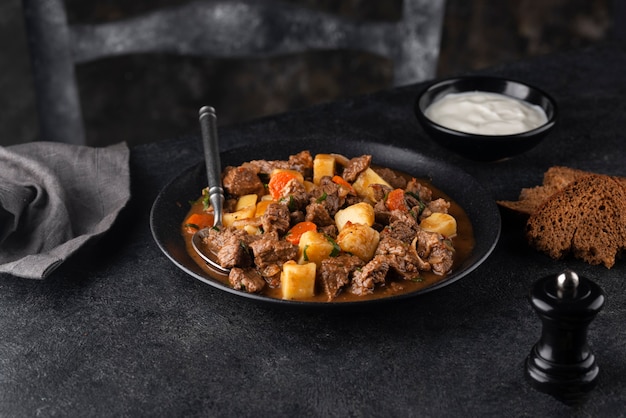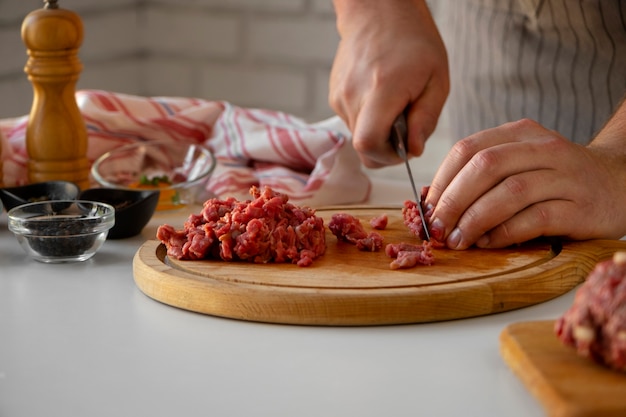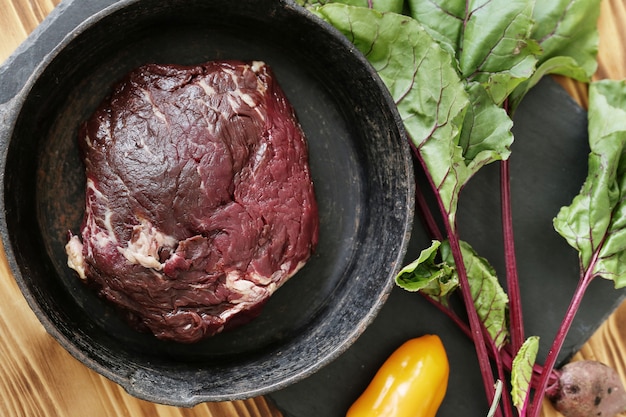Ah, corned beef. The very name conjures up images of hearty meals, family gatherings, and the unmistakable aroma of slow-cooked meat. I’ve been making corned beef for years now, and I’ve learned a thing or two about getting it just right. From the initial preparation to the perfect cooking time, there’s a knack to it, and that’s what I’m going to share with you today. So, grab a cuppa, settle in, and let’s delve into the world of corned beef together.
(Part 1) The Art of choosing the right cut

The first step to a fantastic corned beef is choosing the right cut. Now, I'm not talking about a posh butcher's shop here. Any decent supermarket will have what you need. Look for a brisket - that's the cut you want. It's the classic choice for corned beef, and for good reason. It's got a good amount of fat marbling, which gives you lovely, juicy flavour. You'll find two types: flat brisket and point brisket.
Flat Brisket vs. Point Brisket - What's the Difference?
Flat brisket is leaner, with less fat. It's a bit more tender, making it great for slicing thin. It's the ideal choice for sandwiches, but it might not be as flavourful as the point. Point brisket, on the other hand, is packed with flavour. It's got a thicker layer of fat, which renders down during cooking, adding incredible flavour. This makes it perfect for braising and slow-cooking. If you're unsure, just ask your butcher for their recommendation. They'll be able to advise you based on your preferences and the recipe you're making.
Choosing the Right Size
Another thing to consider is the size of your brisket. A smaller brisket will cook faster, but a larger one will be more impressive. It really depends on how many people you're feeding. For a small family, a 2-3 lb brisket is perfect. If you're feeding a crowd, go for a bigger one, like 4-5 lbs. You can always adjust the cooking time based on the size of your brisket.
(Part 2) Prepping Your Brisket - A Deep Dive

Now, before you even think about the oven, you need to prepare your brisket. It's a crucial step that shouldn’t be rushed. This is where you get to truly appreciate the craft of making corned beef.
Unpacking the Mystery - What’s Inside That Package?
You’ll find your brisket comes wrapped in plastic, often with a brine packet nestled alongside. This brine is the heart of corned beef. It's a mixture of salt, sugar, spices, and sometimes even nitrates, which gives the meat its distinctive flavour and colour. And don’t worry - it’s safe to eat! It's the process of brining that transforms a simple piece of beef into the delicious, savory corned beef we know and love.
Let’s Get Brining
So, you've got your brisket. First thing's first: take it out of the packaging and give it a good rinse under cold water. Now, you’ve got two options: you can either put the brisket in a large pot and pour the brine over it, or you can follow a more traditional method and soak it in the brine. If you're opting for the soaking method, find a large, non-reactive container - like a stainless steel pot or a ceramic crock - and place the brisket inside. Then, pour the brine over the brisket, making sure it's completely submerged. Now, you’ll need to refrigerate it for at least 3 days, preferably 5, and up to 7 days. The longer you soak it, the more intense the flavour will be. Remember to flip the brisket every day to ensure even brining. This helps to ensure that all parts of the brisket are evenly seasoned and tenderized.
A Word on Timing - Patience is Key
Here's where patience comes in. The brining process is key to tenderizing the brisket and developing that rich, complex flavour. Don’t be tempted to rush it. Let the brisket soak in the brine, get to know its flavours, and become one with the magic of brining. Patience, my friend, is the key to success. The salt in the brine draws out moisture from the beef, then redistributes it, breaking down tough muscle fibers and infusing the meat with a unique flavor.
(Part 3) The Big Reveal - Cooking Your Corned Beef

You've waited patiently, the anticipation is building, and now it's time to cook your corned beef. You’re ready to dive into the heart of the cooking process. Take a deep breath, you’ve got this!
Getting Ready for the Oven - What You’ll Need
Gather your equipment: a large, oven-safe pot or dutch oven is ideal, a slotted spoon or tongs to help you maneuver the brisket, and a meat thermometer to ensure your beef is cooked to perfection. Now, let’s get started.
Cooking Your Corned Beef - Follow the Recipe!
Firstly, preheat your oven to 325 degrees Fahrenheit (165 degrees Celsius). Then, take your brisket out of the brine and pat it dry. It’s time to get that flavour going, so add a generous amount of your favorite seasonings. I love to use peppercorns, bay leaves, and garlic cloves - but feel free to experiment. A little bit of onion powder and paprika can add another dimension of flavour.
Next, place the seasoned brisket in the pot. If you’ve used a brine packet, make sure to add that to the pot too. You can also add some additional water or broth, just enough to cover the brisket by an inch or two. Cover the pot tightly with a lid, and place it in your preheated oven. And now, the waiting game begins!
(Part 4) Patience is a Virtue - How Long to Cook Your Corned Beef
Cooking a corned beef is a marathon, not a sprint. This isn't a dish you rush. It requires time, patience, and a bit of intuition. You’re not just cooking a piece of meat; you’re nurturing its transformation into a culinary masterpiece.
The Rule of Thumb
The general rule of thumb is to cook your corned beef for about 3-4 hours per pound. So, a 3-lb brisket would take 9-12 hours. However, there’s always a bit of room for improvisation. The size of the brisket, its thickness, and your oven can all influence the cooking time.
Checking the Temperature - Your Guide to Perfection
To make sure your corned beef is perfectly cooked, you’ll need a meat thermometer. This is an essential tool to help you avoid overcooking or undercooking your brisket. You want to aim for an internal temperature of 190 degrees Fahrenheit (90 degrees Celsius) at the thickest part. Once the brisket reaches that temperature, it's done! You can check the temperature every hour or so, especially during the last few hours of cooking. This allows you to adjust the cooking time as needed to ensure your corned beef is cooked to perfection.
Resting - A Crucial Step
Once the brisket is cooked, it's not ready to be sliced just yet. Let it rest in the pot, covered, for at least 30 minutes. This allows the juices to redistribute throughout the meat, resulting in a more tender and flavorful final product. Don’t skip this step! It really makes a difference.
(Part 5) Mastering the Art of Slicing
You've waited patiently, your corned beef is cooked to perfection, and now it’s time for the big reveal - slicing. This is where you get to see the fruits of your labor. The slicing stage is crucial for getting the most out of your corned beef.
The Ultimate Slicing Tools
You'll need a sharp knife with a long, thin blade. A carving knife is ideal, but if you don’t have one, a chef's knife will do the trick. A cutting board is also essential. Choose one that's sturdy and large enough to accommodate your brisket.
The Art of Slicing - Getting It Right
Now, take your brisket out of the pot and place it on the cutting board. Slicing against the grain is crucial for achieving a tender and succulent final product. So, identify the grain - the direction the muscle fibers run - and slice perpendicular to it. This will break down the fibers and make the meat easier to chew.
Start by slicing the brisket into thin, even slices, about ?? inch thick. This allows the flavors to shine through and makes it easier to eat.
(Part 6) Savoring the Flavor - Serving and Enjoying Your Corned Beef
The moment you’ve been waiting for has finally arrived - it’s time to savor the fruits of your labor. Enjoy your culinary triumph!
Classic Corned Beef Dishes - A Culinary Delight
Corned beef is a versatile dish with a myriad of serving options. The classic way to enjoy it is on rye bread with mustard. But don’t stop there! You can also use it for other dishes, like:
- Corned beef hash: A hearty, comforting dish made with corned beef, potatoes, onions, and spices. It’s a perfect weekend brunch.
- Reubens: A classic sandwich filled with corned beef, sauerkraut, Swiss cheese, and thousand island dressing. It’s a real crowd-pleaser!
- Corned beef and cabbage: A traditional Irish dish that is a must-have for St. Patrick’s Day celebrations. It’s a hearty and flavorful meal that is perfect for a cold winter day.
- corned beef soup: A comforting and flavorful soup that is perfect for a chilly day. It can be made with a variety of vegetables, such as carrots, potatoes, and celery.
- corned beef tacos: A fun and unexpected twist on traditional tacos. Use corned beef as a filling for tacos, and add your favorite toppings, such as salsa, sour cream, and cilantro.
Feel free to experiment with different toppings and side dishes to create your own unique corned beef masterpiece.
Leftovers - A Culinary Blessing
If you have any leftover corned beef, don’t throw it away! Leftover corned beef is even more flavorful than the first time around. It can be used for sandwiches, hash, soups, and stews. It’s also a great way to add a boost of flavor to salads.
Preserving the Flavor - Tips and Tricks
You can also freeze leftover corned beef. To do this, wrap it tightly in plastic wrap and aluminum foil and place it in the freezer. Corned beef can last in the freezer for up to 3 months.
(Part 7) Exploring the World of Corned Beef - Beyond the Basics
Now you're on your way to becoming a corned beef maestro. There's still so much to discover, so let's delve deeper into the world of corned beef.
Beyond the Oven - Alternative Cooking Methods
While the oven is a classic method for cooking corned beef, there are other ways to achieve delicious results. If you're looking for a faster option, you can try cooking your corned beef in a slow cooker. Just add the brisket, brine, and some liquid to the slow cooker, and cook on low for 8-10 hours. You can also try cooking it in a pressure cooker. This method cooks the meat incredibly quickly, and the results are tender and flavorful.
Spicing Up the Flavor - Experimenting with Seasonings
Don't be afraid to experiment with your seasonings. In addition to the traditional peppercorns, bay leaves, and garlic cloves, you can add other spices like ginger, coriander, mustard seeds, and black peppercorns to add complexity and depth of flavor.
For a sweeter flavour, you can add a little bit of brown sugar or molasses. For a smoky flavour, you can add a few smoked paprika or chipotle peppers. And for a more pungent flavour, you can add a few juniper berries.
The possibilities are endless, so feel free to explore different flavour combinations and create your own unique corned beef masterpiece. Experimenting with different spice combinations is a great way to personalize your corned beef and create a dish that reflects your own culinary style.
(Part 8) The Art of Corned Beef - A Culinary Tradition
Making corned beef isn't just about following a recipe. It's about embracing a culinary tradition that has been passed down through generations. It’s about the warmth of sharing a meal with loved ones, the joy of creating something delicious, and the satisfaction of mastering a culinary art.
The History of Corned Beef - A Journey Through Time
Corned beef has a fascinating history, dating back to ancient times. The Romans used salt to preserve meat, and this technique spread throughout Europe. In the 17th century, corned beef became a popular food in Ireland and was brought to the United States by Irish immigrants.
It quickly gained popularity as a cheap and nutritious source of protein for working-class families. It became a staple of the American diet, particularly in the Northeast.
Today, corned beef is enjoyed by people from all walks of life. It’s a dish that brings people together, reminding us of our shared history and culinary traditions. The history of corned beef is a testament to its enduring appeal and its ability to connect people across cultures and generations.
(Part 9) Beyond the Plate - Fun Facts about Corned Beef
Now, let's have a bit of fun with some fascinating facts about corned beef.
Fact 1: The Origins of the Name
The name "corned beef" comes from the fact that the meat was originally cured with large grains of salt, which were called "corns." The term "corned" actually refers to the process of salting the meat, not the use of any kind of corn.
Fact 2: Corned Beef is a Global Food
While corned beef is particularly popular in the United States, it's enjoyed around the world. In the Philippines, it’s a popular street food, often served in sandwiches or with rice. In South Africa, it’s often served with pap and vegetables. It has even found its way into the culinary traditions of countries like Brazil and Argentina.
Fact 3: A Culinary Icon
Corned beef has been featured in countless books, films, and television shows. It's a true culinary icon that has captured the imaginations of people around the world. From the classic “Corned Beef and Cabbage” scene in the movie “The Godfather” to its appearances in popular TV shows, corned beef has a unique ability to capture the attention and appetites of audiences everywhere.
(Part 10) FAQs - Your Questions Answered
You've embarked on the journey of making corned beef, and you might have some questions along the way. Let’s tackle some of the most common ones.
1. Can I use a pre-brined brisket?
Absolutely! You can certainly use a pre-brined brisket, making the process even quicker. Just follow the cooking instructions on the package, and you'll be enjoying delicious corned beef in no time. This can be a great option if you're short on time or don't want to go through the full brining process yourself.
2. Can I make corned beef in a slow cooker?
Yes! Slow cookers are a great way to make corned beef. Simply place the brisket, brine, and some liquid in the slow cooker, and cook on low for 8-10 hours. You'll end up with tender and flavorful corned beef. The slow cooker does a fantastic job of tenderizing the meat and allowing the flavors to develop slowly.
3. How do I know if my corned beef is cooked?
You'll want to use a meat thermometer to ensure your corned beef is cooked to perfection. Aim for an internal temperature of 190 degrees Fahrenheit (90 degrees Celsius) at the thickest part of the brisket. It’s important to cook the corned beef to a safe internal temperature to ensure it is safe to eat.
4. Can I freeze leftover corned beef?
Yes, you can definitely freeze leftover corned beef! Just wrap it tightly in plastic wrap and aluminum foil, and place it in the freezer. It will keep well for up to 3 months. This is a great way to preserve any leftover corned beef and enjoy it later.
5. What other dishes can I make with corned beef?
The possibilities are endless! Corned beef is a versatile ingredient that can be used for many different dishes, from classic sandwiches and hash to soups, stews, and salads. You can even get creative and use it in dishes like tacos, burritos, or even pizza.
So, there you have it, a comprehensive guide to crafting the perfect corned beef. Now, go out there and create a culinary masterpiece!
Everyone is watching

Corn on the Cob: The Ultimate Guide to Perfectly Cooked Ears
Healthy MealsAh, corn on the cob. Just the name evokes images of sunny days, barbecues, and that sweet, juicy flavour that ...

Scallops: The Ultimate Guide to Perfect Cooking
Healthy MealsAh, scallops. Those delicate, sweet, and utterly delicious morsels of the sea. They hold a special place in my...

Spaghetti Squash: The Ultimate Guide to Cooking and Serving
Healthy MealsRemember that time you saw spaghetti squash at the supermarket, looking all bumpy and strange, and thought, "W...

Salmon Cooking Times: Perfect Guide for Every Recipe
Healthy MealsLet me tell you, cooking salmon is an art form. It's all about getting that perfect balance: juicy and tender,...

Ham Cooking Time: How Long to Bake, Smoke, or Boil a Delicious Ham
Healthy MealsAh, ham. It's a classic, isn't it? A real crowd-pleaser, especially around holidays. And when done right, it'...
